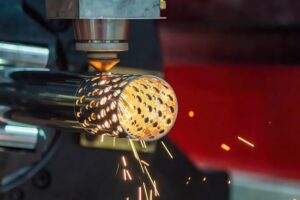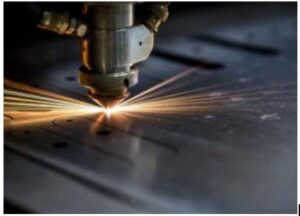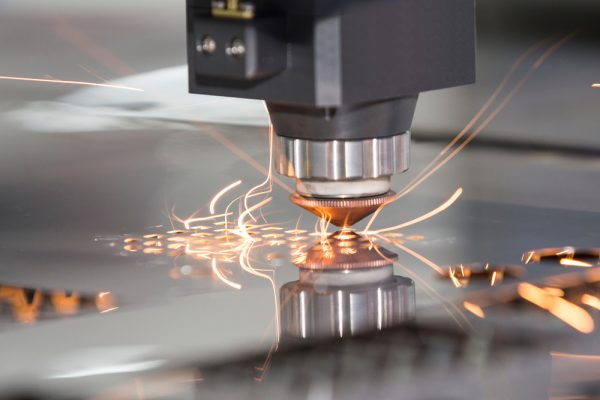The Role of Fiber Laser Cutting in Metal Fabrication Industry
The global manufacturing industry considers the U.S. fabrication sector a cornerstone for long-term growth. It supports industries that include construction, automotive, energy, and aerospace. With the growing demand for efficiency, customization, and precision, the need for cutting-edge technologies is also increasing. One such innovative approach is revolutionizing metal fabrication with preset–fiber laser cutting technology.

From reducing production times to allowing intricate designs, fiber laser cutting is altering the operations of metal fabricators. In this blog, we will discuss how automated fiber laser cutting is shaping the future of metal fabrication in the United States.
What is fiber laser cutting technology?
Fiber laser cutting is a technique that slices through metal using a high-powered, focused beam of light produced by a fiber laser source. Unlike traditional CO2 lasers, fiber lasers utilize optical fibers to amplify the beam. It results in a more effective, reliable, and compact cutting procedure.
This technology is especially effective for cutting materials, including:
- Stainless steel
- Carbon steel
- Aluminum
- Brass
- Copper
Fiber lasers provide high-speed, precision cutting with minimal heat-affected zones (HAZ), resulting in minimal material warping and cleaner edges. It is a significant benefit for industries requiring precise tolerances.
Benefits of fiber laser cutting in metal fabrication
- Unmatched precision and quality
In industries such as medical device manufacturing and aerospace, precision is non-negotiable. Fiber laser cutting offers superior edge quality and excellent accuracy, making it an ideal choice for custom metal fabrication where intricate geometries and tight tolerances are crucial.
- Increased cutting speeds
Compared with conventional cutting methods such as CO2 lasers or plasma, fiber lasers are capable of cutting materials up to 3-5 times faster. This rapid processing method brilliantly reduces lead times and increases throughput – a remarkable benefit for U.S.-based manufacturers competing in the global market.
- Lower operational costs
Fiber lasers are more energy-efficient than CO2 process and contain fewer moving parts. It results in lowering the operation and maintenance expenses. Over time, this translates into maximum return on investment (ROI), especially for job shops and contract manufacturers that aim for high-volume production.
- Versatile cutting capabilities
With the capability to cut a wide range of materials and thicknesses, fiber lasers are incredibly versatile. If you are working with thin sheet metal or thick structural metal, as a manufacturer, you can rely on this technique for a wide range of applications.
The rise of automated fiber laser cutting
Automation is the new ruler of each technique associated with metal manufacturing. Automated fiber laser cutting systems incorporate CNC controls, software, and robotics to streamline the entire production process. It offers assistance in processes such as material loading and alignment, as well as cutting and unloading.
Key features of automated systems
- Automatic management of material
- Real-time monitoring and diagnostics
- Integrated nesting software for material optimization
- Remote programming and control
Why automation matters
A skilled labor shortage is a potential risk in many sectors of U.S. manufacturing. Hence, automation is no longer a luxury – it is a necessity. Through the implementation of automated fiber laser cutting, fabricators can:
- Eliminate human error
- Elevate productivity
- Minimize downtime
- Maximize machine utilization
Automation also increases repeatability, assuring every part is cut to the exact specifications each time. It is an essential factor for industries such as automotive and defense manufacturing.
Custom metal fabrication meeting unique industry needs
In a market where off-the-shelf solutions often fall short, custom metal fabrication integrated with fiber laser technology enables businesses to meet specific performance and design requirements.
Fiber laser provides the proper flexibility to produce one-off prototypes and complete production runs with similar efficiency. This technique is equally applicable from bespoke architectural elements to precision medical components. Fabricators in the United States are now better equipped than ever to provide customized solutions that align with their clients’ accurate needs.

Applications in the U.S industry
- Construction: Custom frames, brackets, and panels.
- Energy: Wind turbine components and solar panel frames
- Transportation: Lightweight structural components for vehicles
- Electronics: Precision enclosures and heat sinks
Environmental and economic impact
The transformation with fiber laser cutting also supports the concept of environmental sustainability and cost savings. As fiber lasers need less power and produce less waste, they can help companies reduce their carbon footprint. Additionally, higher material utilization rates lead to reduced scrap and, consequently, increased profitability.
Final thoughts
Fiber laser cutting is far more than just a technological upgrade – it can be considered a strategic asset for the current competitive metal fabrication industry. From enhanced efficiency and precision to customization and automation, this advanced technology is driving innovation and development across the United States’ manufacturing industry.
FAQs: Fiber Laser Cutting in Metal Fabrication
Q1: What materials can be cut using fiber laser cutting technology?
Stainless steel, carbon steel, copper, brass, and aluminum are just a few of the metals that fiber lasers can cut. They work particularly well with materials that are thin to medium in thickness.
Q2: How does automated fiber laser cutting benefit U.S. manufacturers?
Automation improves accuracy, decreases long-term operating costs, boosts production efficiency, and lessens dependency on human labor—all crucial benefits in a competitive labor market.
Q3: Is fiber laser cutting suitable for custom metal fabrication projects?
Because fiber laser cutting enables the creation of complex designs, high precision, and rapid prototyping with minimal setup time, it is ideal for custom manufacturing.
Q4: How does fiber laser cutting compare to CO₂ laser cutting?
Compared to CO₂ lasers, fiber lasers are more cost-effective because they use less energy, cut more quickly (particularly on thinner metals), and require less maintenance.
Interested in learning more about how Cresco’s fiber laser cutting technique can benefit your next project? Join us today!
This blog is originally published here: https://crescocustommetals.com/the-role-of-fiber-laser-cutting-in-metal-fabrication-industry/

Comments
Post a Comment